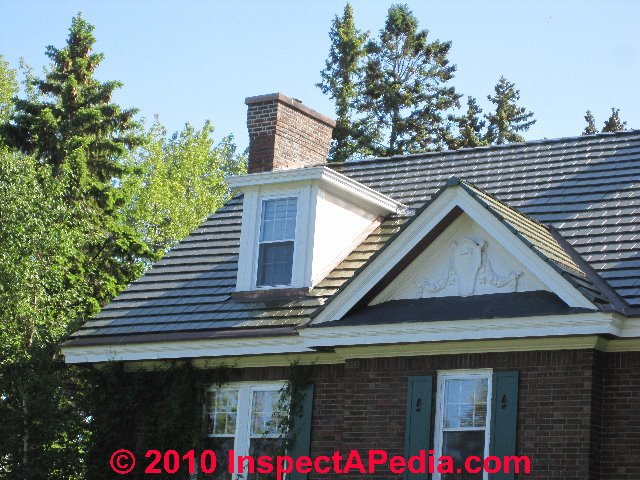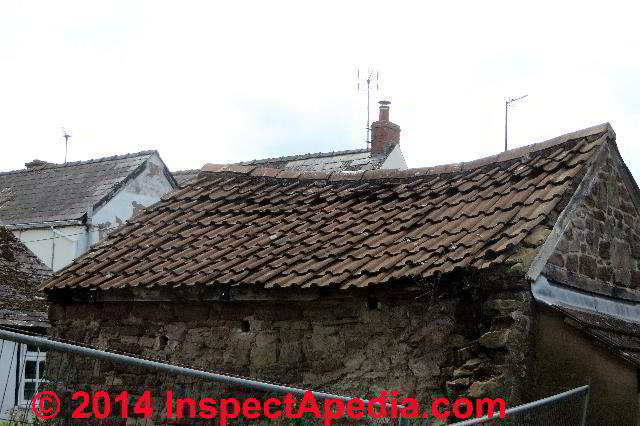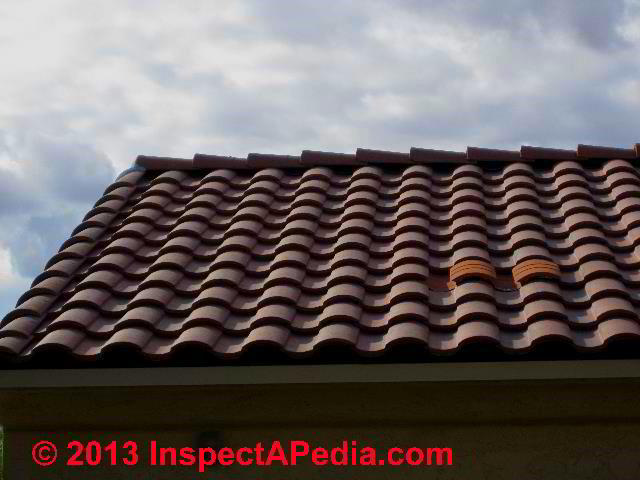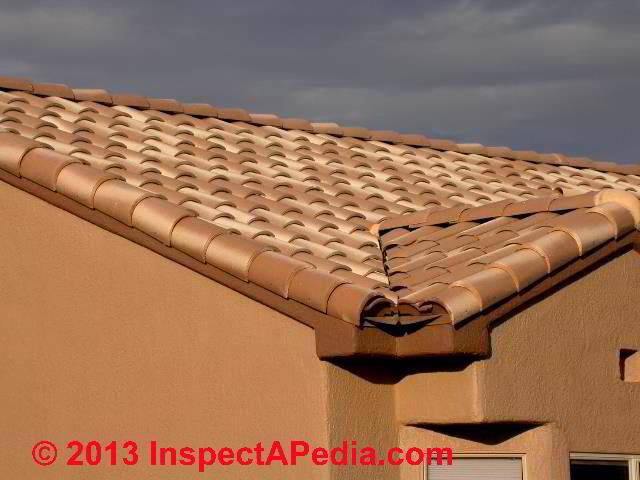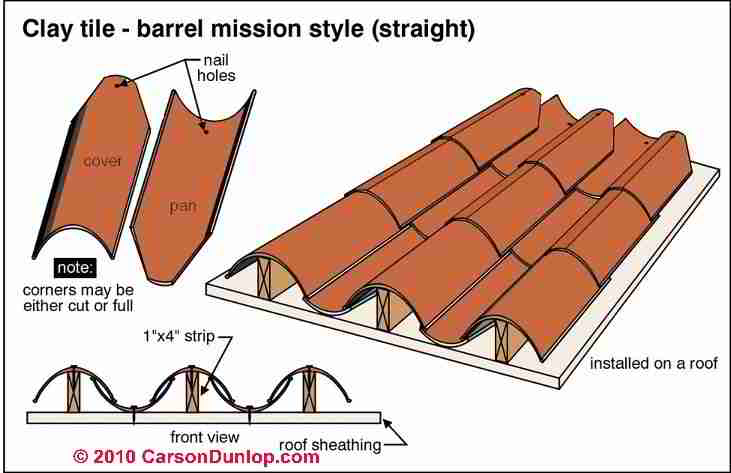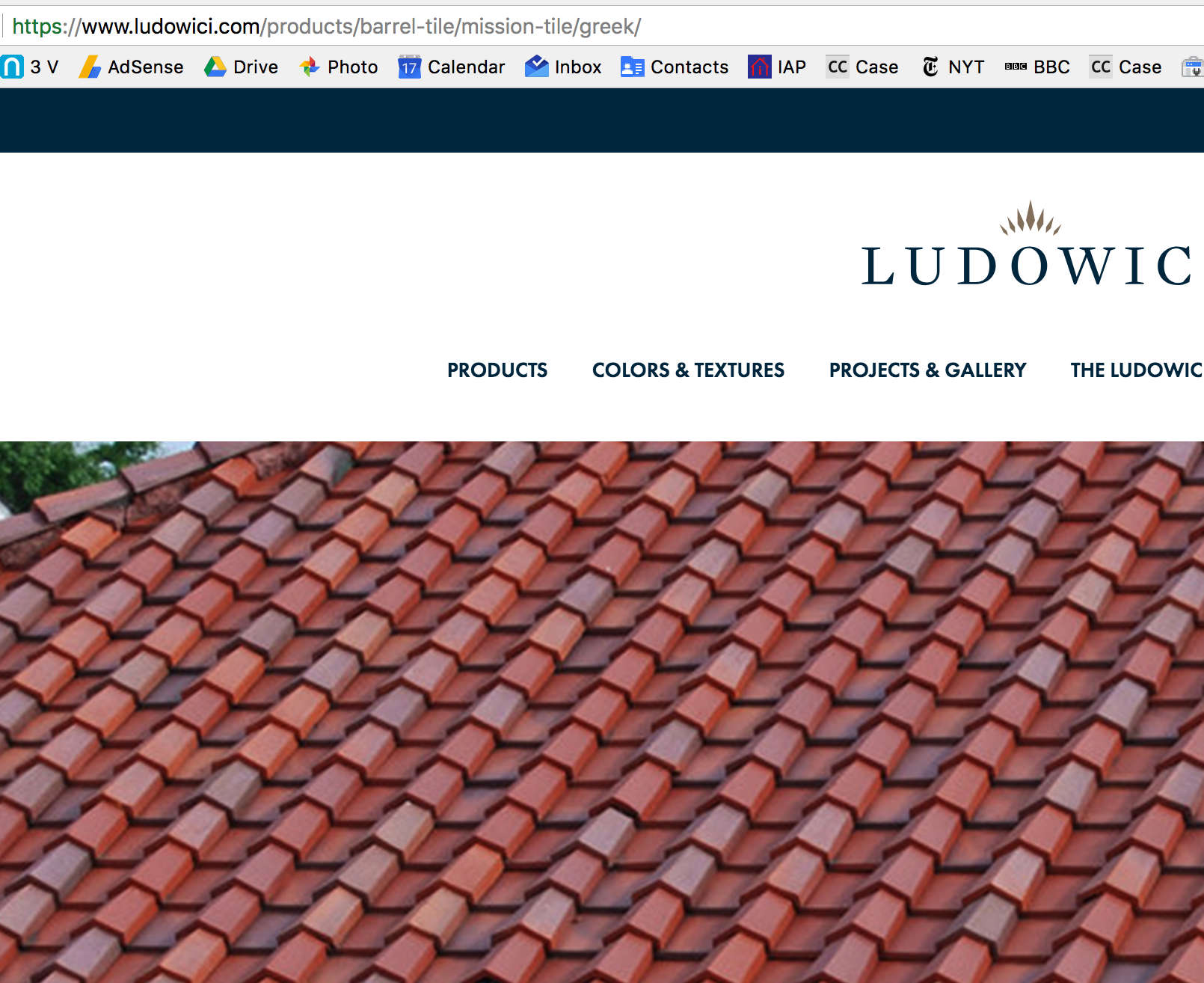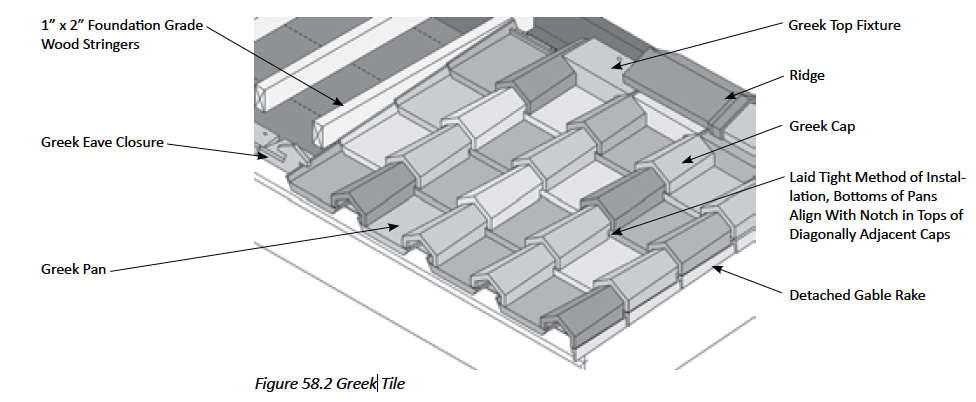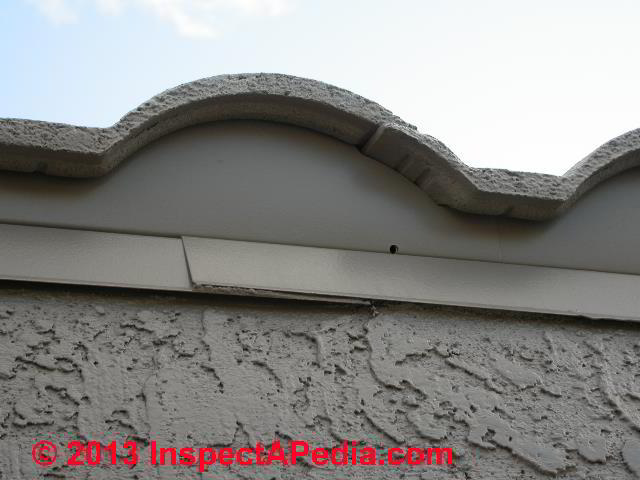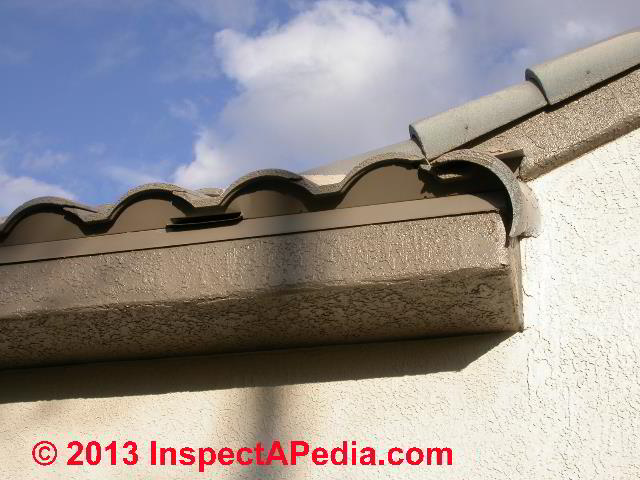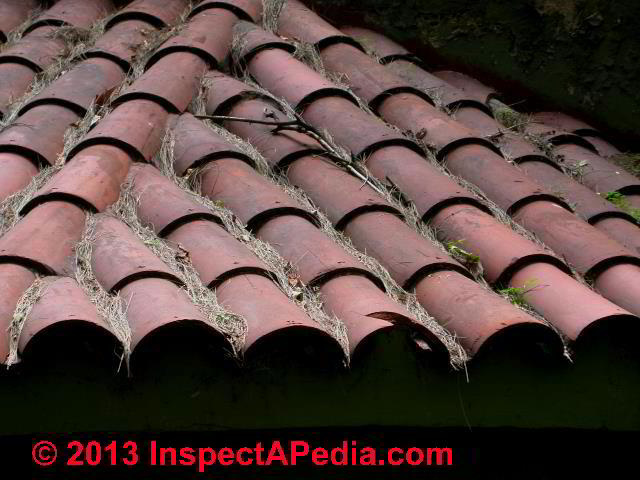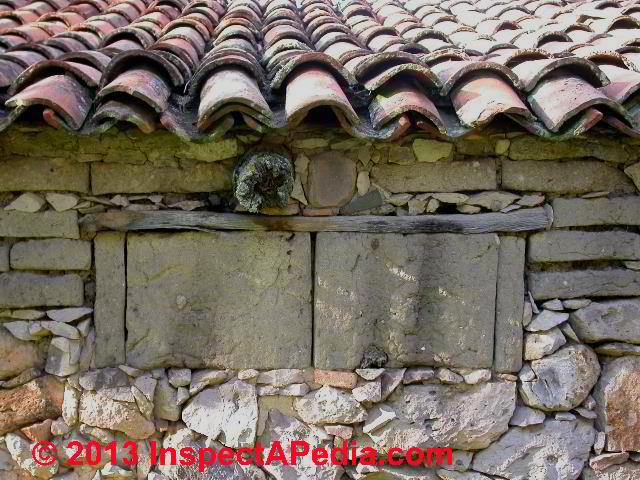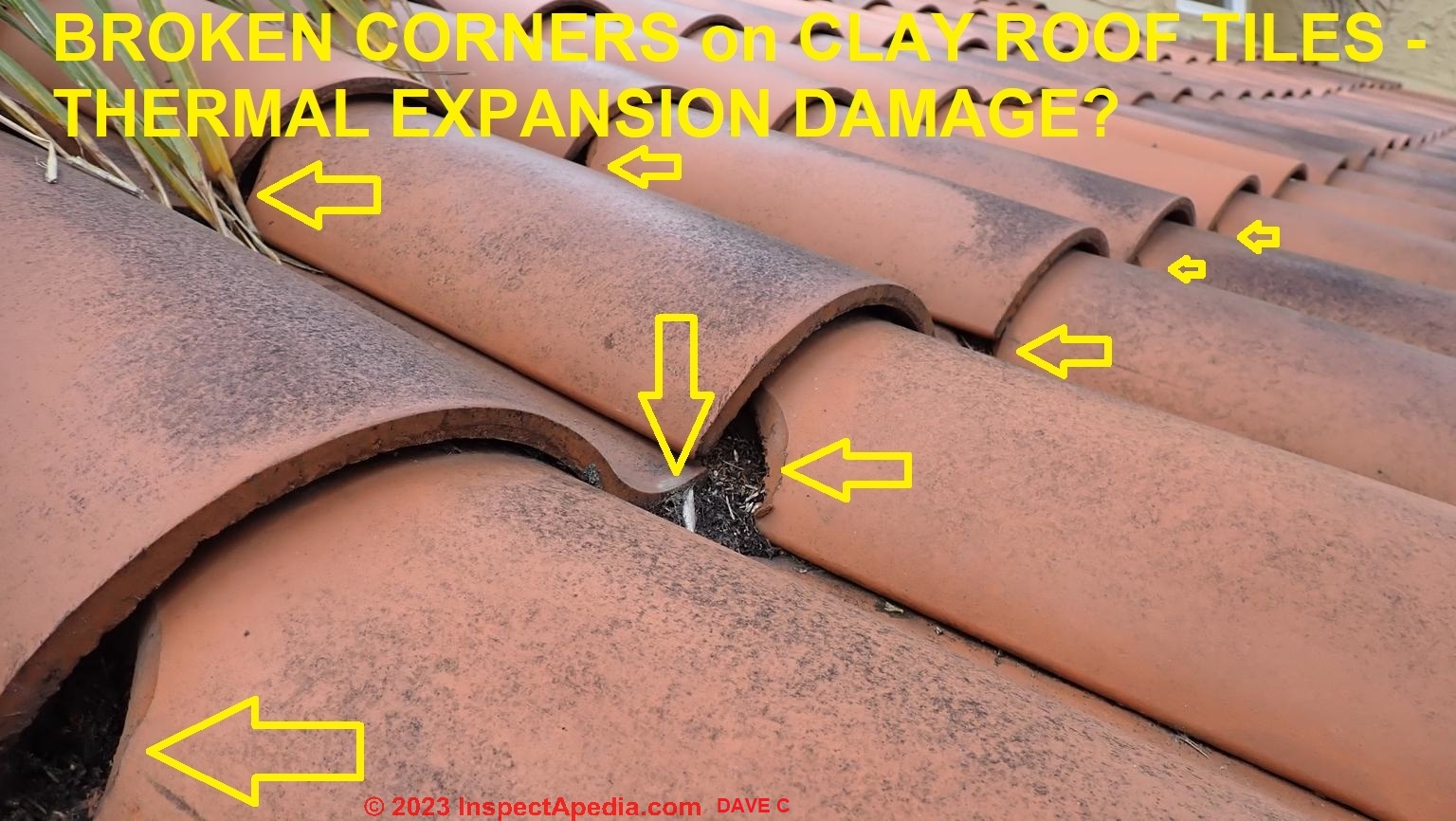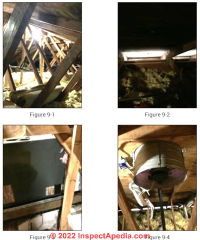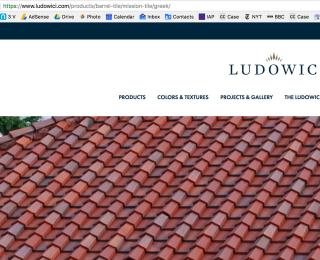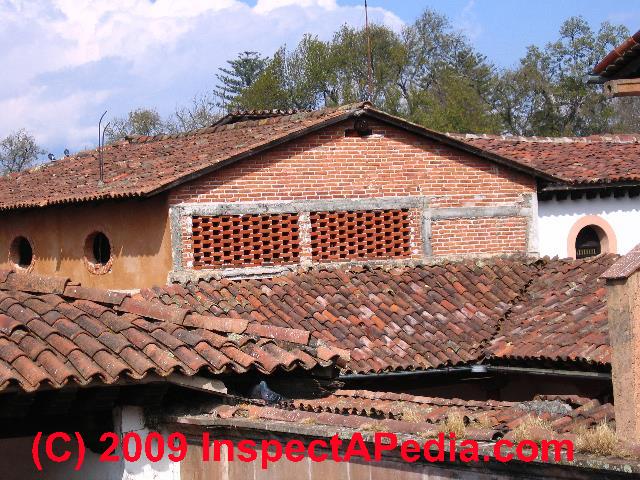 Clay Tile Roof Inspection & Installation Details
Clay Tile Roof Inspection & Installation Details
Home page
- POST a QUESTION or COMMENT about clay tile roof installation, maintenance, inspection & repairs
Clay tile roofs: clay tile roofing types, clay roofing tile inspection, tile roofing diagnosis, & tile roof repair.
S-style clay tiles, Flat Rectangular tiles, and Tapered & Barrel Mission tiles as well as other clay tile forms, shapes, and history are discussed.
Photographs of types of clay tile roofs in the U.S., Korea, Norway, Mexico and other countries are illustrated.
Our page top photo shows clay roofing tiles installed in Patzcuaro, Mexico.
InspectAPedia tolerates no conflicts of interest. We have no relationship with advertisers, products, or services discussed at this website.
- Daniel Friedman, Publisher/Editor/Author - See WHO ARE WE?
Clay Roofing Tile Types, Patterns, Installation, Inspection & Repair
Article Contents
- HISTORY OF CLAY ROOFING TILES IN THE U.S. & OTHER COUNTRIES
- TAPERED & BARREL MISSION CLAY ROOFING TILES
- S-STYLE CLAY ROOFING TILES
- FLAT RECTANGULAR INTERLOCKING CLAY ROOF TILES
- SECURED TILES AND CLOSED EAVES
Real clay tile roofs compared with cosmetic clay tile roofs:
The clay roof tile systems we discuss in this article series are "real" clay tile roofs on which the tiles themselves are intended to provide the water shedding and drainage necessary to form a dry covering over a building.
At left, the very damaged clay tile roof depended on the tiles themselves to carry away rainfall.
But other roofs use clay tiles to protect a waterproof underlayment from sun and for aesthetic reasons.
Such "cosmetic" clay tile roofs are commonly installed in some areas (Boca Raton, Florida) over a completely functional waterproof membrane.
Cosmetic clay tile roofs also protect the roof membrane from deterioration from sunlight, but the tiles themselves are not forming the waterproof covering.
Just below we give a history of clay roof tile use around the world. You will see that clay roofing tiles have an ancient history and a record of serving as a durable roofing material.
History of Clay Roofing Tiles in the U.S. & Other Countries
 Clay roofing tiles have been used in Europe, the Middle East, and Asia, since the Greek and Roman Empires, and the Americas since Europeans arrived there.
Clay roofing tiles have been used in Europe, the Middle East, and Asia, since the Greek and Roman Empires, and the Americas since Europeans arrived there.
Clay tile roofing material is costly to purchase and install, but it can have an indefinite life expectancy.
Our photo (by Daniel Friedman, Seoul Korea, 1966) shows decorative clay roofing on Yongnyong-jon hall, a Korean shrine forming part of the oldest shrine in Korea Jeongjeon, the Jongmyo Confucian shrine constructed by King Jaejo beginning in 1394.
Koreans believed that the royal spirits achieved peace only after their tablets were brought here from Chongjon. Thus, Chongjon enshrined the souls still roaming the earth, while Yongnyong held those who had achieved eternal rest.
As NPS historic preservation expert Sweetser points out,
European settlers used clay tile for roofing as early as the mid-17th century; many pantiles (S-curved tiles), as well as flat roofing tiles, were used in Jamestown, Virginia.
In some cities such as New York and Boston, clay was popularly used as a precaution against such fires as those that engulfed London in 1666 and scorched Boston in 1679.
Wikande (1990) reports on the spread of popular use of clay roof tiles by studying clay roofs dated from 700 to 600 B.C.
Other expert discussions detail of the manufacture of clay tile roofs in Greece are dated to the 7th century B.C. (Sapirstein 2009).
Pan-type and S-profile clay roof tile shapes are perhaps the oldest known, dating back at least to 3000 BC in Greece.
Similar clay roof tile styles were used in China as well as in the Roman empire. Roman terms for this roof tile shape include imbrex and tegula.
Even older durable roof coverings were made of slate and of flat slabs of stone.
Tile roofs found in the mid-18th century Moravian settlements in Pennsylvania closely resembled those found in Germany. Typically, the tiles were 1415" long, 67" wide with a curved butt. A lug on the back allowed the tiles to hang on the lathing without nails or pegs.
Photo below: curving pattern in clay tile roof, San Miguel de Allende, Guanajuato, Mexico. [Click any image for an enlarged, detailed version.]
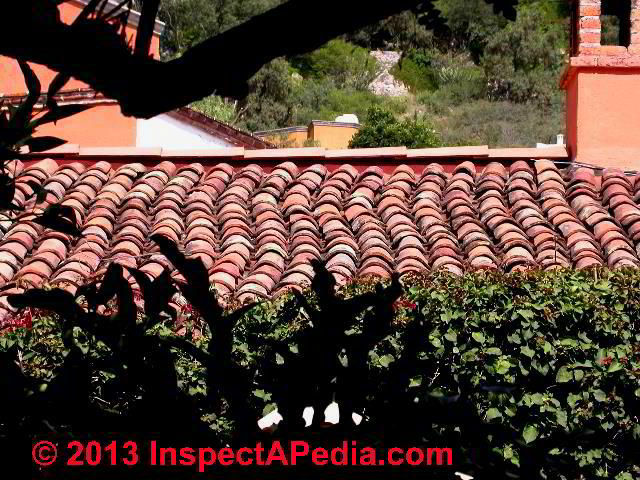 The tile surface was usually scored with finger marks to promote drainage. In the Southwest, the tile roofs of the Spanish missionaries (mission tiles) were first manufactured (ca. 1780) at the Mission San Antonio de Padua in California.
The tile surface was usually scored with finger marks to promote drainage. In the Southwest, the tile roofs of the Spanish missionaries (mission tiles) were first manufactured (ca. 1780) at the Mission San Antonio de Padua in California.
These semicircular tiles were made by molding clay over sections of logs, and they were generally 22" long and tapered in width.
The plain or flat rectangular tiles most commonly used from the 17th through the beginning of the 19th century measured about 10" by 6" by 1/2," and had two holes at one end for a nail or peg fastener. Sometimes mortar was applied between the courses to secure the tiles in a heavy wind.
In the mid-19th century, tile roofs were often replaced by sheet-metal roofs, which were lighter and easier to install and maintain.
However, by the turn of the century, the Romanesque Revival and Mission style buildings created a new demand and popularity for this picturesque roofing material.
Our glazed roof tiles shown below were on homes in freezing climates of Norway (below left) and Duluth, MN (below right). Best Practices Guide to Residential Construction points out that
To make tiles, moist clay is extruded through a die or cast in a mold and then fired in a kiln until the clay “vitrifies,” fusing the particles together.
Complete vitrification will create a strong tile with very low water absorption, which protects tile from freeze-thaw damage in cold climates or damage from salt air in coastal areas.
Where regular freeze-thaw cycling is expected, roof tiles should comply with ASTM C1167 Grade 1, which allows minimal water absorption. Grade II tile provides moderate resistance to frost action, and Grade III tile is porous and should not be used in freeze-thaw areas.
 ...
...
Photo above: highly vitrified glazed clay tile roof in Molde, Norway.
Above, a vitrified clay glazed flat tile roof in Duluth, Minnesota. Both of these roofs tolerate freezing climate and other harsh weather conditions.
The antique clay tile roof shown below is on a building in Ross on Wye, Herefordshire, in the U.K. near Goodrich Castle.
[Click to enlarge any image]
Clay roof tiles, typically 7" x 13" are 1/4" to 1/2" in thickness and are shaped in molds and fired in a kiln to 2000 degF to cause the clay to vitrify.
The vitrification (glasification) process makes the tiles hard and waterproof by melting and fusing silicas and aluminas in the clay.
Clay roofing tile surfaces may also be decorated with an embossed pattern to resemble wood, slate, or stone.
Unglazed tiles are terra-cotta red, a color provided by iron oxide in the clay.
Clay roof tiles may also be made with a colored glaze, adding both color and an additional layer of hard surface protection.
While traditional clay tile glazing was performed by hand dipping and pouring glazing compound over the tiles, Carson Dunlop point out in their Home Study Course for home inspectors, since the 1970's, glazing on clay tiles has been spray applied and the tile backs are left unglazed, both reducing tile cost and permitting moisture to escape from the back surface of the tile.
In between the soft, fragile unglazed low-fired clay tiles of Mexico and South America and the hard-fired glazed roofing tiles used in northern climates are harder-fired but unglazed clay roofing tiles we see in frequent use in Arizona where tolerance for sun makes these a long-lived material compared with lower-cost asphalt shingle roof coverings.
The clay tile roof shown above is located near Phoenix, Arizona.
The clay tile roof shown below is on a building located in Surprise, Arizona.
Both flat and curved clay tiles are in wide use in the American Southwest.
Higher quality clay roofing tiles are kiln fired to a higher temperature, are harder, less porous, and thus more durable. Inexpensive clay roofing tiles that are fired to lower temperatures insufficient to achieve vitrification are soft, easy to break, and less water resistant.
Tapered Mission Clay Tiles & Barrel Mission Clay Roofing Tiles

Carson Dunlop Associates' sketch above illustrates the traditional tapered mission style clay roof tiles, and below, the less-rounded barrel-mission style clay roof tiles.
[Click to enlarge any image]
All of the rounded mission tile roofing materials need to be enclosed at the eaves or lower roof edge to avoid blowing rain and wind (wind-lift damage) and animal entry. Tile end closure is discussed
at HOW CLAY ROOFING TILES ARE SECURED.
Reader Question: do Greek-style Roof tiles require concrete for installation?
2018/05/21 Lesley said:
Is concrete used when laying Greek s shaped roof tiles?
Illustrations: Greek roof tiles, a peaked S-shaped or pan-style clay roofing tile produced by Ludowici roofing and others, cited in detail just below. Contact the company for additional details about this product and its installation.
[Click to enlarge any image]
Reply: No.
Lesley,
No, no concrete or cement is used in the field of the roof.
Greek pan-type roofing tiles, also described as pan tiles or mission tiles, are not installed using concrete.
Noticing that Ludowici's Greek style clay roof tiles are a pan tile design we infer that that Lesley's question confuses "Greek roof tiles", S-tiles, and Pan-tiles since Lesley referred to Greek S-tiles.
Below I will include an excerpt from Ludowici's BARRELL TILE INSTALLATION MANUAL [PDF] cited below.
These tiles are also described as "Roman tiles" - the tile has a flat lower pan or for curved tiles, a concave pan on one side (usually the left) and a convex pan or (usually the right side). S-tiles and pan-tiles interlock side-to-side.
Distinguish between pan tiles and s-tiles simply by noticing that pan tiles have a wider, flat area such as is shown in these Greek tiles illustrated here.
Details about clay roofing tile shapes, profiles, styles, types are
at CLAY TILE ROOF STYLES, DESIGNS for detailed descriptions of different clay roof tile styles and characteristics.
Also
see ROOFING TILE SHAPES & PROFILES where, using concrete roof tiles as an example, we discuss the basics of roof tile profiles and what they mean.
...
S-style Clay Roofing Tiles Clay Roof Tiles
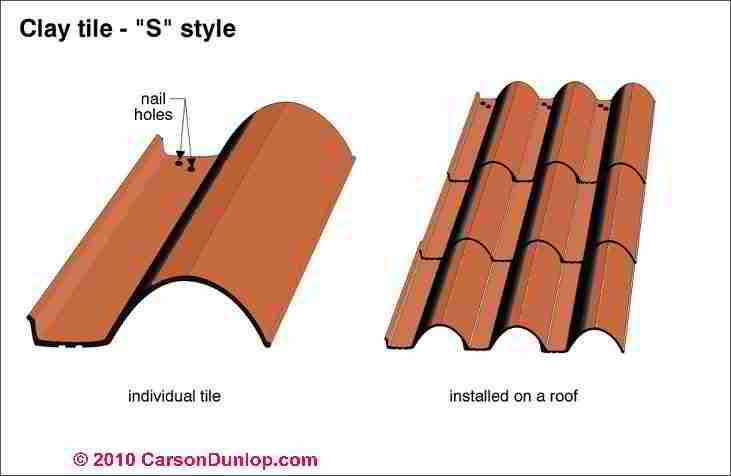
Carson Dunlop Associates' sketch illustrates the Spanish roofing tile that is roughly "S" shaped, including the pan or drainage trough on the left side of the tile and the raised tile surface on its right side.
Variations of these interlocking tiles include a lower-profile "S" tile and also Greek and Roman clay roof tiles.
...
Flat Rectangular Interlocking Clay Roof Tiles
Our photo (below) and Carson Dunlop's sketch (above) illustrate a typical interlocking roofing tile that is flat.

In our photo you can see metal tabs that mark the location of inserted replacement or repair clay tiles.
The tabs should be bent up over the tile edges but appeared to have been flattened by snow sliding down the roof.
This clay tile roof was located near New York City. Lots of these tiles were broken, particularly on the low slope roof section: we suspected some of the clay tile roof damage was due to foot traffic.
We recommend against walking on clay tile roofs as you are likely to damage the roof leading to the need for costly repairs.
Our photo of broken clay roof shingle-tiles (above right) was taken during an inspection made without walking on the roof surface - for obvious reasons: we didn't want to shoulder the blame for this damage.
Our photo of a tarred roof valley and damaged interlocking clay roof tiles (above) was taken from a ladder at roof edge.
See ROOF INSPECTION SAFETY & LIMITS where we provide more photographs of this roof (Walking on Clay Roofs).
That article explains roof safety and roof damage issues when inspecting, repairing, or otherwise walking on clay tiles as well as other roof materials such as asphalt, slate, and wood roofs.
...
How Clay Roof Tiles are Secured On the Roof & How Open Eaves are Closed
The illustrations of of how clay roof tiles are secured (above) and of typical eaves closure of the open ends of Spanish or mission style roof tiles was provided courtesy of Carson Dunlop Associates, a Toronto home inspection, education & report writing tool company [ carsondunlop.com ].
Details about clay roofing tile fastening specifications are now found
at CLAY TILE ROOF CONNECTIONS.
The tile roof eaves closure and drain openings shown above and below are on homes in Surprise, Arizona. Notice the larger drain opening in the eaves closure for the roof at below right. [Click to enlarge any image.]
Photo below: is a mission style clay tile roof with an open eaves design, Buenos Aires, Argentina.
At below right is an open eaves clay tile roof design in Molde, Norway.
Clay tile roof eaves are also left open routinely in warmer climates such as Mexico, Central and South America, as we illustrate below with this roof from Xotolar, Guanajuato, Mexico.
...
Clay Roof Tile Roofing Associations, Manufacturers, Sources, Standards History, Manuals
andSources of clay roofing tiles, roof tile fastening systems, & Clay Tile Roof Installation Details
can now be found at
- Portions of this page were adapted with permission from Best Practices Guide to Residential Construction (Steve Bliss, J Wiley & Sons) .
...
Reader Comments, Questions & Answers About The Article Above
Below you will find questions and answers previously posted on this page at its page bottom reader comment box.
Reader Q&A - also see RECOMMENDED ARTICLES & FAQs
On 2023-04-17 by Dave C - small curved cracking at the top left corner of clay tile roofing
What causes this small curved cracking at the top left corner of s tile roofing. Nearly every corner is cracked in the same manner.
On 2023-04-18 by InspectApedia Publisher
@Dave C,
I'm not sure, but I suspect that the corners were snipped off by the installer.
Are the tiles secured to a roof deck below or are they simply placed loosely in situ?
Are these tiles installed over a waterproof membrane?
And please tell me the country and city of locations so that I have an idea of the climate.On 2023-04-18 by Dave C
I have seen this more than once. Not sure how well the tiles are secured since I did not remove any of them. The tiles are installed over felt underlayment. The climate is coastal Southern California. You can't see it, but the lower right corner of the tile has a bevel, or is angled, but can't tell if the upper left had the same bevel because it is broken.
On 2023-04-18 by InspectApedia Editor - Likely causes of consistent corner breakage in clay roof tiles
@Dave C,
If there's nothing but 15# or 30# felt under those tiles, I'm concerned that the roof isn't very weather-proof and may leak where broken upper corners are not fully beneath the down-roof end of the tile above.
Likely causes of consistent corner breakage in clay roof tiles, all same location and similar in size:
Cause #1. Most-Likely: For the S-tile shape in your photo, if the tiles were installed a bit too tight together at their sides and in a climate exposed to intense sun (eg. SOCAL), the corner of an upper tile may press against the side of the upper end of the tile course below leading to breakage due to thermal expansion.
This cause is easy to diagnose if you inspect the roof carefully: you'll find at least some of the broken-off corners still on the roof, under the broken/damaged tile. So if you can do so, take a closer look and post photos of what you find.
The underlying cause in this damage case would be improper installation for the environment: clay roof tiles installed side-butted too tightly together.
(This doesn't occur with concrete tiles whose form demands more-precise installation position with respect to one another).
Cause #2. I've seen consistent corner damage on clay roof tiles that were damaged in shipping and handling. In that case because they're stacked directly atop one another, an impact or mis-handling of a pallet of tiles can break off all of the corners on one side of a lot of tiles in a similar pattern.
If the damage is quite small and is on the UP-ROOF end of a clay roof tile, a roofer might use the tiles anyway, figuring that the damaged or chipped corner is amply-covered by the next course of tiles up the roof.
Depending on the clay tile shape, design, and installation specs, a 3-inch overlap of the successive course of tiles over the upper ends of the lower course of tiles should leave NO exposed holes or openings.
So if these were tiles damaged before installation or during installation, when the broken corner is as large as in your photos, such that holes in the roof are left exposed, I'd consider that a bad job. And it seems too extensive for this to be the cause for the roof in your photo.
Unlikely causes of extensive broken corners on clay roof tiled:
I'd be surprised if all or most of the tiles on a roof would all break off at upper corners spontaneously or in response to hail. And on rare occasion I've seen roofers break off a bit of tile corners to make the next up-roof tile course sit more flat - for some soft Mexican tile roofs whose tiles are not as uniform as those in your photo.
This is not damage caused by walking on the roof - that breaks tiles from the top along their length (mostly, and not uniformly all over the roof), nor do I think it'd be associated with hailstorm damage.
I've seen roofs damaged by installation of inadequately cured or "green" tiles that are too soft to withstand handling, but I don't think that damage shows up as consistent corner snap-offs. But indeed some clay tile roofers report that installing "green" or "too-fragile" clay tiles results in a roof more vulnerable to damage from thermal expansion. IMO it's more-likely a "too tight" positioning problem.
Also take a look at
CLAY TILE ROOF DAMAGE & WEAR
On 2023-01-12 by jAMES LINDEN - Do 1999-era Clay Tile Roofs meet UL Standard 2218 Classification for Impact Resistance?
Do clay tile roofs manufactured in 1999 meet the UL 2218 classification for impact? - On 2023-01-12 by jAMES LINDEN
On 2023-01-12 by InspectApedia Publisher - Impact standards for clay & concrete roof tiles
@jAMES LINDEN,
Thank you for a helpful and important question.
I'm sorry we can't give an unequivocal answer but as my friend Mark Cramer says ... "It depends" ... clay roofing tiles are manufactured world-wide, for centuries. The standards to which clay roof tiles were manufactured in 1999 depend on the country where they were made, and the standard to which they claim to meet.
We'd need to identify the specific clay roofing tile about which you're concerned, naming its manufacture and the specific product identity and of course where it was made. The clay tile product literature will (or should) give us the standards to which the clay tiles were manufactured. But I'm doubtful of most clay roof tile products - ones made really of clay, not of a plastic or metal lookalike.
For other readers:
UL 2218 Impact Resistance of Prepared Roof Covering Materials (2018) that specifies hail damage resistant certain roofing products. This impact test standard is a steel ball drop test to evaluate the impact resistance of prepared roof coverings. I'd provide a copy but I'm not going to spend between $400 and $1000. USD on this.
Abstract:
UL 2218, 2nd Edition, November 29, 2022 - UL Standard for Safety Impact Resistance of Prepared Roof Covering Materials
This test method provides impact resistance data for the evaluation of prepared steep slope roof covering materials. For purposes of this Standard, prepared roof covering materials are considered to be small units, sheets or panels designed for installation with multiple layers of such materials installed in overlapping rows on slopes of 2:12 (16.67%) and greater.
Impact resistance testing for the evaluation of low slope roofing systems are covered under UL 2218A, Impact Resistance of Roofing Systems.
The test evaluates the effect of impact from the steel ball at locations on the test assembly selected to be most vulnerable, such as (but not limited to) edges, corners, unsupported sections and joints.
This test method does not evaluate the effect of weathering, temperature, aging or similar effects on the impact resistance of prepared roof covering materials. These and other factors, including time, roof slope, roof system configuration and application influence the performance of prepared roofi covering materials in the field. It is not the objective of this test to address all of these factors.
The impact energies used in this Standard were derived from impact energies of actual hailstones (see Appendix A). However, largely due to the effects discussed in 1.3, there is no currently established direct correlation between the performance of prepared roof covering materials when impacted by hailstones versus steel balls.
Consequently, this test method does not provide a direct basis to compare expected performance under all hail conditions, but does provide a basis for comparison of the response of the prepared roof covering materials when subjected to the impact energies described herein.
--
IMPACT STANDARDS for CLAY & CONCRETE ROOF TILES
FM 4473 - Class 4 - Factory Mutual Research, using pure water frozen ice balls to test the impact resistance of new rigid roof coverings like concrete roof tiles, clay roof tiles, and roofing slate. Ice balls are shot at the roof using a sling or an air cannon, and the product must still be "functional" following two impacts in the same spot hit by 2-inch ice balls (to achieve a Class 4 Impact Rating).
IBHS, HAIL RESISTANCE SUPPLEMENT, FORTIFIED HOME [PDF] Fortified IBHS Program, Web: fortifiedhome.org - retrieved 2023/01/12 original source: https://fortifiedhome.org/wp-content/uploads/2020-FORTIFIED-Home-Hail-Supplement.pdf
Website excerpt: FORTIFIED is a voluntary construction and re-roofing Program designed to strengthen homes and commercial buildings against specific types of severe weather such as high winds, hail, hurricanes and even tornados.
ASTM C1167-22 Standard Specification for Clay Roof Tiles
Abstract
This specification covers clay roof tiles with such durability and appearance that can provide a weather-resistant surface of a specified design. Each tile should be manufactured from clay, shale, or similar naturally occurring earthy substances and subjected to high-temperature firing. The heat treatment should develop a fired bond between material particles that provides the required strength and durability.The tiles should be shaped by molding, pressing, or extrusion during manufacture. Generally, the tiles are planar or undulating rectangular and are classified into three grades according to the degree of resistance to weathering. Materials are also grouped into three types according to profile and rise-to-width ratio.
Colors and textures produced by application of inorganic coatings are allowed except when the coloring is done by flashing or the texturing by sanding where the sand does not form a continuous coating. Each tile should conform to the specified values of durability, freezing and thawing, transverse breaking strength, efflorescence, reactive particulates, and permeability.
Scope
1.1 This specification covers clay tiles intended for use as roof covering where durability and appearance are required to provide a weather-resistant surface of specified design.
1.2 Tiles are manufactured from clay, shale, or similar naturally occurring earthy substances and subjected to heat treatment at elevated temperatures (firing). The heat treatment must develop a fired bond between the particulate constituents to provide the strength and durability requirements of this specification (see firing and fired bond in Terminology C1232).
1.3 Tiles are shaped during manufacture by molding, pressing, or extrusion and it is permitted to use the shaping method to describe the tiles.
1.4 Tiles are generally planar or undulating rectangular shapes available in a variety of cross-sectional profiles, shapes, sizes, surface textures, and colors.
1.5 Three grades of tile having various degrees of resistance to weathering are covered in this specification. Three types of tile are defined to cover the features that influence appearance.
1.6 The text of this specification references notes and footnotes which provide explanatory material. These notes and footnotes (excluding those in tables and figures) shall not be considered as requirements of the standard.
1.7 The values stated in inch-pound units are to be regarded as standard. The values given in parentheses are mathematical conversions to SI units that are provided for information only and are not considered standard.
1.8 This standard does not purport to address all of the safety concerns, if any, associated with its use. It is the responsibility of the user of this standard to establish appropriate safety, health, and environmental practices and determine the applicability of regulatory limitations prior to use.
1.9 This international standard was developed in accordance with internationally recognized principles on standardization established in the Decision on Principles for the Development of International Standards, Guides and Recommendations issued by the World Trade Organization Technical Barriers to Trade (TBT) Committee. - https://www.astm.org/c1167-22.html
Other References on Hail & Impact Resistant Roofing
The IIBHS (Insurance Institute for Business & Home Safety, ibhs.org) has published a report summarizingthe RELATIVE IMPACT RESISTANCE OF ASPHALT SHINGLES IN UL 2218 TESTS (AUGUST 2014) [PDF] but does not report on clay roof tiles nor other materials - 2023/01/12 original source: https://ibhs.org/wp-content/uploads/member_docs/Relative-Impact-Resistance-of-Asphalt-Shingles_IBHS.pdf
The Class 1 projectile is 1.25 in. in diameter,
Class 2 is 1.50 in., Class 3 is 1.75 in., and Class 4 is 2.00 in.
This is about hail damage resistance as describe in this articleSince before 2019, clay and concrete roof tiles sold in North America (you don't give your country of location) are required to meet a CLASS 4 Impact Rating as described in UL 2218. This standard is descibed as developed by UL (Underwriters Laboratories) for assessing the impact resistance of "new flexible roofing products, like metal panels or metal shingles.
Reading lists of roofing products that meet that standard I don't see clay roofing tiles in the list but my survey was not exhaustive.
For a roof tile to meet the standard it's probably going to be made of synthetics such as a plastic formulation.
Examples of IMPACT RESISTANT ROOFING PRODUCTS [PDF] (as listed by Texas), 2022/01/12, original source: https://www.tdi.texas.gov/company/roofing-discounts.html
include (*examples, not an exhaustive list)
Crowe Building Products Ltd.
Ontario, Canada
Phone: 905-529-6818
Web Address: www.authentic-roof.com
Baljen TPO Polymer Roof Tiles - Class 4
DaVinci Roofscapes, LLC.
Kansas City, KS
Phone: 800-328-4624
Web Address: www.davinciroofscapes.com
Premium Polymer Roofing Tiles - Class 4
EcoStar LLC
Holland, NY 14080
Phone: 800-211-7170
Web Address: www.ecostarllc.com
Molded Polymer Roof Tiles - Class 4
On 2022-09-18 by John Sam Hotchkiss - can we restore these flat clay roof tiles from 1927?
We’d like to restore this 1927 roof along with the home. These flat clay roof tiles are not easy to find. Any help would be great! They measure 15 1/2” x 7 1/2” (18 x 39 cm). Thanks!
This entire reader question, photos, and our responses
can now be found in the Reader Q&A section
On 2022-09-15 by Martin - this website is an incredible wealth of information! Need help with replacing/repairing a Montreal clay tile roof
Hi, this is an incredible wealth of information! I purchased a house in Montreal, built in 1953, with a flat roof and a clay tile "corona" around it. I have a very hard time finding any contractor at all that is able to repair and/or renew that roof.
Here is a pic of my tiles, taken from the flat top. The corner pieces seem a bit special.
best regards - Martin
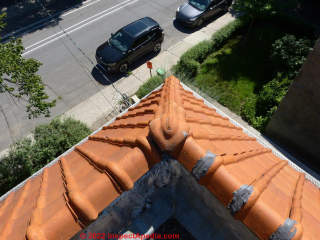
This entire reader question, photos, and our responses
can now be found in the Reader Q&A section
On 2021-08-26 by SHIVANAND - how much does clay tile roofing cost?
Clay tile roof 1000 sqft house what is the cost
On 2021-08-26 by inspectapedia.com.moderator - cost of a clay tile roof varies enormously by country and city
@SHIVANAND,
The cost of a clay tile roof varies enormously by country and city where the building is located, both because of differences in labor and material costs and because in some climates such as high-wind or hurricane or storm zones, different, storm-resistant designs are required.
For example, in central Mexico, clay tiles are simply laid in place on low slope roofs, held atop asphalt roofing felt or other coatings by gravity, while in Florida, tiles are bound to the roof sheathing, usually over a heavy waterproof membrane.
A TYPICAL range for clay tile roof costs in the U.S. and Canada is between $10. and $20 per square foot, so your roof, if it's in one of those countries, would cost between $10,000 and $20,000.
On 2021-08-15 by Mitzi Borota
I am trying to sell my home and the inspection found a leak. I need a fast repair pictures included. I am in Brandon Florida.
On 2021-08-15 by inspectapedia.com.moderator - black plywood that may be actually leak-damaged
@Mitzi Borota,
We took a look at another of the inspector's photos of your roof and saw a lot of black plywood that may be actually leak-damaged at the lower roof-edge (photo below). So your repair may involve removal of some of the roof tiles and may require some plywood replacement.
There are a lot of clay tile roofs in Florida so there are a lot of clay tile roof installers. A simple web search for "Clay tile roof repairs, Brandon Florida " using any search engine will give you a list of roofers near you.
In order to absolutely assure our readers that we write and report without bias we do not sell any products nor do we have any business or financial relationships that could create such conflicts of interest.
InspectAPedia is an independent publisher of building, environmental, and forensic inspection, diagnosis, and repair information for the public - we have no business nor financial connection with any manufacturer or service provider discussed at our website.@Mitzi Borota, for example here's a search result with map of clay tile roofers near you; give these companies a call.
Question: How do I Find a Roofer Who Knows how to Work on Clay Tile Roofing?
Nancy said:
We have the original clay tile roof from 1948 when the house was built. Flat clay tiles, not the Mediterranean type.
Pacific Northwest. We've had trouble finding a company that is knowledgeable about this type of roof, and no one seems to know how to repair or clean this roof. Any references for companies that have experience with this type of roof in Washington state? - 2017/08/07
This question was posted originally
Reply:
Thanks for the note, Nancy - nice evidence that well-made clay roof tiles can last well for 60-years and longer.
Like you, I have found that in many cities most roofers working on residential properties specialize in installing asphalt shingles and that the number of roofers who are familiar with clay tile, ceramic tile, slate, and similar materials that require more specialized skills is a smaller, harder to find group.
It can help to recognize that roofers who know to work on tile also often can work on slate, and vice versa.
I have found that a simple google search for CLAY TILE ROOFERS in PACIFIC NORTHWEST or CLAY TILE ROOFERS IN SEATTLE (for example) will certainly come up with companies saying they specialize in those roof materials.
You might ask if there's a roof job they've done and drive by to see if the roof looks like it's in place and is tile. Some roofers also give prior clients as referrals but it may help to hear my experience (I've done roofing work as well as other contracting):
1. I don't much like disturbing my prior clients asking them to accept calls from strangers unless the client has specifically offered to provide recommendations. It can be intrusive, invade privacy, and unannounced it could upset a prior client to be bothered.
2. no roofer with any sense is going to send you to a client who was not happy with their work
So I might ask about how long they've been in business, their specific experience with clay tile roofing, and their warranty terms for their work. I might also never make a final payment before I was sure the job was properly finished.
3. It might be interesting to ask the roofer if they're a member of TRI - and they'll say "what's TRI" - which is itself informative; TRI is a trade association that's been around since 1971, the Tile Roofing Institute located in Seattle - Tile Roofing Institute, 2150 N 107th St. Ste 205, Seattle, WA 98133 Tel: 206-209-5300 Email: info@tileroofing dot org Website: tileroofing.org
That institute also has a "find a tile roof contractor" button on their home page.
I would not insult good tile roofers by asserting that every tile roofer must be a member of TRI, but on the other hand, folks in any field who take the extra time and trouble to find out about the best practices of their trade get an extra plus in my book.
Also take a look at ROOFING CONTRACTOR, FIND & CHOOSE [live link is given just below on this page]
where you'll find other helpful advice about selecting which roofer should work on your home
On 2020-03-16 by yessica henriquez - what's the name of this roof tile and where can I find more?
Can someone please tell what is the name of this clay tile and where I can buy it.
This entire reader question, photos, and our responses
can now be found in the Reader Q&A section
On 2020-02-08 by adelm - can I repair a clay roof tile with different tiles?
Does anyone know if a permit would be issued on a roof repair using a different clay tile not original on the roof? Current roof has ALTUSA "S" clay tile made in Venezuela which is discontinued and obsolete.
On 2020-02-09 - by (mod) -
Should not be an issue as long as the type of tile and its fastening method meet local wind and storm codes.
Concrete needed to secure Greek S-shape tiles to Roof?
Is concrete used when laying Greek s shaped roof tiles - On 2018-05-21 by Lesley:
Reply by (mod) - No
No, no concrete or cement is used in the field of the roof.
Greek S-shaped roofing tiles, also described as pan tiles or mission tiles, are not installed using concrete. Below I will include an excerpt from Ludowici's roof tile installation manual [PDF], Ludowici Roof Tile, Inc. 4757 Tile Plant Rd. P.O. Box 69 New Lexington, OH 43764 USA, Tel: 1-800-945-8453 Website: www.Ludowici.com retrieved 2018/05/21, original source: https://www.ludowici.com/products/barrel-tile/mission-tile/greek/
I will also show an excerpt from the company's website that illustrates for other readers the profile of Greek mission roof tiles in a subsequent post. Contact the manufacturer directly for more details.

Here is what a Ludowici greek roof tile looks like
Question: What is the minimum slope for a tile roof?
(Feb 18, 2013) what is minimum roof degree requ said:
what is minimum roof degree require for clay roof tile
Reply: waterproof membrane required beneath roofs at slope under 3:12
About minimum slope allowed for clay tile roofs or other tile roofs, if you read through standards such as
ICC-ES-ESR2015 "Concrete and Clay Roof Tile Installation Manual for Moderate Climates" (copy on file) you'll see that there is no prohibition of clay tiles on low slope roofs. Rather for slopes at 3:12 or less the installer is required to install a BUR or similar waterproof membrane on the roof below the tiles.
The document I cite is available from the Roofing Institute - the Western States Roofing Contractors Association (TRI/WSCRA) and other sources.
I give contact information for the Tile Roofing Institute in the article above,
Question: why do I see daylight through the tile roof? Does that mean it leaks?
(Jan 25, 2013) Anonymous said:
I am in process of Purchasing a home with spanish clay tile without underlayment. We checked for water leaks and surprisingly there are none but on a sunny day, we can see the light poking through the holes...How could that be?
Can someone advise if it is safe to purchase it. There are [no] water stains either
5/2/2014 Rob said:
Hi anonymous, hopefully I can catch you. I am curious about what happened in your situation. I just found out that the home I really want to buy has the same problem with no underlayment (concrete tiles,not clay).
Reply:
Rob and Anon,
On some roof designs, particularly if there is sufficiently steep slope, in the attic one might observe daylight filtering in through the roof covering for a slate or clay tile roof that is installed on spaced nailers.
The roof may never leak, given pitch and adequate head lap of the slates or tiles, OR it may leak horribly if there is wind-driven rain blowing water up-slope.
In that circumstance on an older home the observation of leak stains on the nailers or on the floor below would be helpful clues telling us that the roof has or has not leaked.
"Safe to purchase" is too big and vague a question to answer by text with almost no information about a building.
...
Continue reading at CLAY TILE ROOF BATTENS & STACKING or select a topic from the closely-related articles below, or see the complete ARTICLE INDEX.
Or see these
Recommended Articles
- CLAY HOLLOW TILE CONSTRUCTION - Structural clay tile, terra cotta, building tiles
- CLAY TILE / PAVER TILE FLOORING
- CLAY TILE ROOFING - home
- CLAY TILE ROOF BATTENS & STACKING
- CLAY TILE ROOF CONNECTIONS
- CLAY TILE ROOF DAMAGE & WEAR
- CLAY TILE EAVES, HIP & RAKE DETAILS
- CLAY TILE ROOF FLASHING
- CLAY TILE ROOF FLASHING LEAKS
- CLAY TILE ROOF SLOPE, DECK & UNDERLAY
- CLAY TILE ROOF SPECIFICATIONS
- CLAY TILE ROOF SUPPLIERS
- CLAY TILE ROOF STYLES, DESIGNS
- CLAY TILE ROOFING
- CLAY TILE WIND & SEISMIC CONNECTORS
- CLAY, CONCRETE, FIBER CEMENT ROOF TILE CHOICES
- CONCRETE, MASONRY BLOCKS, & BRICKS, WORKING WITH
- CONCRETE ROOFING
- DURALITA & METAL TILE ROOFS
- EFFLORESCENCE: WHITE DEPOSITS on ROOFS
- ROOFING CONTRACTOR, FIND & CHOOSE
- ROOFING TILE SHAPES & PROFILES - for both clay or concrete roof tiles
- SLATE ROOF INSPECTION & REPAIR
Suggested citation for this web page
CLAY TILE ROOFING at InspectApedia.com - online encyclopedia of building & environmental inspection, testing, diagnosis, repair, & problem prevention advice.
Or see this
INDEX to RELATED ARTICLES: ARTICLE INDEX to BUILDING ROOFING
Or use the SEARCH BOX found below to Ask a Question or Search InspectApedia
Ask a Question or Search InspectApedia
Try the search box just below, or if you prefer, post a question or comment in the Comments box below and we will respond promptly.
Search the InspectApedia website
Note: appearance of your Comment below may be delayed: if your comment contains an image, photograph, web link, or text that looks to the software as if it might be a web link, your posting will appear after it has been approved by a moderator. Apologies for the delay.
Only one image can be added per comment but you can post as many comments, and therefore images, as you like.
You will not receive a notification when a response to your question has been posted.
Please bookmark this page to make it easy for you to check back for our response.
IF above you see "Comment Form is loading comments..." then COMMENT BOX - countable.ca / bawkbox.com IS NOT WORKING.
In any case you are welcome to send an email directly to us at InspectApedia.com at editor@inspectApedia.com
We'll reply to you directly. Please help us help you by noting, in your email, the URL of the InspectApedia page where you wanted to comment.
Citations & References
In addition to any citations in the article above, a full list is available on request.
- Best Practices Guide to Residential Construction, by Steven Bliss. John Wiley & Sons, 2006. ISBN-10: 0471648361, ISBN-13: 978-0471648369, Hardcover: 320 pages, available from Amazon.com and also Wiley.com. See our book review of this publication.
- Mark Cramer Inspection Services Mark Cramer, Tampa Florida, Mr. Cramer is a past president of ASHI, the American Society of Home Inspectors and is a Florida home inspector and home inspection educator. Mr. Cramer serves on the ASHI Home Inspection Standards. Contact Mark Cramer at: 727-595-4211 mark@BestTampaInspector.com
- John Cranor [Website: /www.house-whisperer.com ] is an ASHI member and a home inspector (The House Whisperer) is located in Glen Allen, VA 23060. He is also a contributor to InspectApedia.com in several technical areas such as plumbing and appliances (dryer vents). Contact Mr. Cranor at 804-873-8534 or by Email: johncranor@verizon.net
- Duralita: produces cement & cardboard corrugated and clay tile-like roofing products: Duralita is a combination of cement and cardboard - see www.duralita.com/ Si tiene alguna pregunta, por favor escribanos a: sales@duralita.com - El Salvador: +503 22.25.57.44 ext.31 USA +1 305.677.3597
- Terry Rubin, proprietor of the Posada del Bosque Encantado can be contacted at gringamaya@yahoo.com or call (502) 5208-5334 or (502) 4146-1050 use 011 (502) from the US.
- "Tile Roofs in Snow Country: The Natural Choice For Aesthetics and Durability Proper planning and installation ensure a tile roof with elegance, durability, and low maintenance for premier resort in Vail, Colorado", Mark Wennstedt, Source Products Group, 303 280-9595 - Web Search 07/12/2010 - Original Source http://pdfone.com/download/12_keyword-roof-shingles/tile-roofs-in-snow-country.pdf
- Roof Tiling & Slating, a Practical Guide, Kevin Taylor, Crowood Press (2008), ISBN 978-1847970237,
If you have never fixed a roof tile or slate before but have wondered how to go about repairing or replacing them, then this is the book for you. Many of the technical books about roof tiling and slating are rather vague and conveniently ignore some of the trickier problems and how they can be resolved. In Roof Tiling and Slating, the author rejects this cautious approach. Kevin Taylor uses both his extensive knowledge of the trade and his ability to explain the subject in easily understandable terms, to demonstrate how to carry out the work safely to a high standard, using tried and tested methods.
This clay roof tile guide considers the various types of tiles, slates, and roofing materials on the market as well as their uses, how to estimate the required quantities, and where to buy them. It also discusses how to check and assess a roof and how to identify and rectify problems; describes how to efficiently "set out" roofs from small, simple jobs to larger and more complicated projects, thus making the work quicker, simpler, and neater; examines the correct and the incorrect ways of installing background materials such as underlay, battens, and valley liners; explains how to install interlocking tiles, plain tiles, and artificial and natural slates; covers both modern and traditional methods and skills, including cutting materials by hand without the assistance of power tools; and provides invaluable guidance on repairs and maintenance issues, and highlights common mistakes and how they can be avoided. The author, Kevin Taylor, works for the National Federation of Roofing Contractors as a technical manager presenting technical advice and providing education and training for young roofers. - Building Pathology, Deterioration, Diagnostics, and Intervention, Samuel Y. Harris, P.E., AIA, Esq., ISBN 0-471-33172-4, John Wiley & Sons, 2001 [General building science-DF] ISBN-10: 0471331724 ISBN-13: 978-0471331728
- Concrete Roofing Tile, History of the, Batsford, 1959, AISN B000HLLOUC (availble used)
- Handbook of Building Crafts in Conservation, Jack Bower, Ed., Van Nostrand Reinhold Company, NY 1981 ISBN 0-442-2135-3 Library of Congress Catalog Card Nr. 81-50643.
- Tile Roofs of Alfred: A Clay Tradition in Alfred NY
- History of the Concrete Roofing Tile, Batsford, 1959, AISN B000HLLOUC (availble used)
- Our recommended books about building & mechanical systems design, inspection, problem diagnosis, and repair, and about indoor environment and IAQ testing, diagnosis, and cleanup are at the InspectAPedia Bookstore. Also see our Book Reviews - InspectAPedia.
- Best Practices Guide to Residential Construction, by Steven Bliss. John Wiley & Sons, 2006. ISBN-10: 0471648361, ISBN-13: 978-0471648369, Hardcover: 320 pages, available from Amazon.com and also Wiley.com. See our book review of this publication.
- Building Pathology: Principles and Practice, David Watt, Wiley-Blackwell; 2 edition (March 7, 2008) ISBN-10: 1405161035 ISBN-13: 978-1405161039
- Handbook of Building Crafts in Conservation, Jack Bower, Ed., Van Nostrand Reinhold Company, NY 1981 ISBN 0-442-2135-3 Library of Congress Catalog Card Nr. 81-50643.
- Historic Preservation Technology: A Primer, Robert A. Young, Wiley (March 21, 2008) ISBN-10: 0471788368 ISBN-13: 978-0471788362
- Historic Slate Roofs : With How-to Info and Specifications, Tina Skinner (Ed), Schiffer Publishing, 2008, ISBN-10: 0764330012 , ISBN-13: 978-0764330018
- Problems in Roofing Design, B. Harrison McCampbell, Butterworth Heineman, 1991 ISBN 0-7506-9162-X (available used)
- Roofing The Right Way, Steven Bolt, McGraw-Hill Professional; 3rd Ed (1996), ISBN-10: 0070066507, ISBN-13: 978-0070066502
- Slate Roofs, National Slate Association, 1926, reprinted 1977 by Vermont Structural Slate Co., Inc., Fair Haven, VT 05743, 802-265-4933/34. (We recommend this book if you can find it. It has gone in and out of print on occasion.)
- The Slate Roof Bible, Joseph Jenkins, www.jenkinsslate.com, 143 Forest Lane, PO Box 607, Grove City, PA 16127 - 866-641-7141 (We recommend this book).
- Smart Guide: Roofing: Step-by-Step Projects, Creative Homeowner (Ed), 2004, ISBN-10: 1580111491, ISBN-13: 978-1580111492
- Solar heating, radiative cooling and thermal movement: Their effects on built-up roofing (United States. National Bureau of Standards. Technical note), William C Cullen, Superintendent of Documents, U.S. Govt. Print. Off (1963), ASIN: B0007FTV2Q
- In addition to citations & references found in this article, see the research citations given at the end of the related articles found at our suggested
CONTINUE READING or RECOMMENDED ARTICLES.
- Carson, Dunlop & Associates Ltd., 120 Carlton Street Suite 407, Toronto ON M5A 4K2. Tel: (416) 964-9415 1-800-268-7070 Email: info@carsondunlop.com. Alan Carson is a past president of ASHI, the American Society of Home Inspectors.
Thanks to Alan Carson and Bob Dunlop, for permission for InspectAPedia to use text excerpts from The HOME REFERENCE BOOK - the Encyclopedia of Homes and to use illustrations from The ILLUSTRATED HOME .
Carson Dunlop Associates provides extensive home inspection education and report writing material. In gratitude we provide links to tsome Carson Dunlop Associates products and services.



